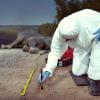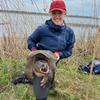With new technologies revolutionizing data collection, wildlife researchers are becoming increasingly able to collect data at much higher volumes than ever before. Now we are facing the challenges of putting this information to use, bringing the science of big data into the conservation arena. With the help of machine learning tools, this area holds immense potential for conservation practices. The applications range from online trafficking alerts to species-specific early warning systems to efficient movement and biodiversity monitoring and beyond.
However, the process of building effective machine learning tools depends upon large amounts of standardized training data, and conservationists currently lack an established system for standardization. How to best develop such a system and incentivize data sharing are questions at the forefront of this work. There are currently multiple AI-based conservation initiatives, including Wildlife Insights and WildBook, that are pioneering applications on this front.
This group is the perfect place to ask all your AI-related questions, no matter your skill level or previous familiarity! You'll find resources, meet other members with similar questions and experts who can answer them, and engage in exciting collaborative opportunities together.
Just getting started with AI in conservation? Check out our introduction tutorial, How Do I Train My First Machine Learning Model? with Daniel Situnayake, and our Virtual Meetup on Big Data. If you're coming from the more technical side of AI/ML, Sara Beery runs an AI for Conservation slack channel that might be of interest. Message her for an invite.
Header Image: Dr Claire Burke / @CBurkeSci

Explore the Basics: AI
Understanding the possibilities for incorporating new technology into your work can feel overwhelming. With so many tools available, so many resources to keep up with, and so many innovative projects happening around the world and in our community, it's easy to lose sight of how and why these new technologies matter, and how they can be practically applied to your projects.
Machine learning has huge potential in conservation tech, and its applications are growing every day! But the tradeoff of that potential is a big learning curve - or so it seems to those starting out with this powerful tool!
To help you explore the potential of AI (and prepare for some of our upcoming AI-themed events!), we've compiled simple, key resources, conversations, and videos to highlight the possibilities:
Three Resources for Beginners:
- Everything I know about Machine Learning and Camera Traps, Dan Morris | Resource library, camera traps, machine learning
- Using Computer Vision to Protect Endangered Species, Kasim Rafiq | Machine learning, data analysis, big cats
- Resource: WildID | WildID
Three Forum Threads for Beginners:
- I made an open-source tool to help you sort camera trap images | Petar Gyurov, Camera Traps
- Batch / Automated Cloud Processing | Chris Nicolas, Acoustic Monitoring
- Looking for help with camera trapping for Jaguars: Software for species ID and database building | Carmina Gutierrez, AI for Conservation
Three Tutorials for Beginners:
- How do I get started using machine learning for my camera traps? | Sara Beery, Tech Tutors
- How do I train my first machine learning model? | Daniel Situnayake, Tech Tutors
- Big Data in Conservation | Dave Thau, Dan Morris, Sarah Davidson, Virtual Meetups
Want to know more about AI, or have your specific machine learning questions answered by experts in the WILDLABS community? Make sure you join the conversation in our AI for Conservation group!
No showcases have been added to this group yet.
- @RobynneKotze
- | Dr
Conservation Director - Conservation of Natural Ecosystems Trust (CONNECT)
- 0 Resources
- 1 Discussions
- 7 Groups
I'm a PhD in Ecology and Evolution and co-founder of Hacking Ecology, where I coordinate projects at the intersection of open technologies and environmental data. My academic background includes investigating climate-driven shifts in microbial diversity within aquatic ecosystems.
- 0 Resources
- 0 Discussions
- 7 Groups
- @LouisaRC
- | she/her
LRC Wildlife Conservation
With 20 years of experience as a conservation practitioner, I have transitioned from a carnivore scientist to Dean, mentoring Africa’s next generation of conservation leaders. Now, as a consultant, I develop strategies integrating innovative Web 3.0 technologies for conservation.

- 4 Resources
- 1 Discussions
- 4 Groups
Wildlife photographer with a focus on conservation. Collaborating with conservation projects around the world.
- 0 Resources
- 0 Discussions
- 6 Groups
- @Ilia
- | He/Him/His
I am a PhD Student in Computer Science at Iowa State University. I serve as a computational advisor and Director of Evaluation for the Human-Augmented Analytics Group (HAAG).
- 0 Resources
- 0 Discussions
- 3 Groups
Fauna & Flora
Remote Sensing Scientist, Conservation Technology & Nature Markets @ Fauna & Flora - WILDLABS Geospatial Group Co-Lead



- 42 Resources
- 49 Discussions
- 9 Groups
- @Antoinette
- | she/her
Director of Bring The Elephant Home. PhD in Biological Science with a thesis called “Aligning Elephant Conservation with Societal Aspirations”. Master of Arts in Biology at Miami University with dissertations on human-elephant coexistence solutions.
- 0 Resources
- 0 Discussions
- 3 Groups
- @tcsmith
- | he/him
I am a conservation biologist interested in modeling social-ecological systems.
- 0 Resources
- 0 Discussions
- 11 Groups
- @Aurel
- | She/Her
Looking to reconcile biodiversity conservation and finance.


- 2 Resources
- 1 Discussions
- 10 Groups
- @Lysa001
- | she/her
Conservation Biologist
- 0 Resources
- 0 Discussions
- 15 Groups
- @LucyD
- | She/Her
Software developer and wildlife ecologist


- 0 Resources
- 2 Discussions
- 5 Groups
Natural Solutions

- 0 Resources
- 17 Discussions
- 10 Groups
Join the FathomNet Kaggle Competition to show us how you would develop a model that can accurately classify varying taxonomic ranks!
4 March 2025
Up to 48 months contract - 14+22 (+12) | Belvaux
25 February 2025
Up to 6 months internship position to work on DiMON project which aims to develop a non-lethal, compact device that, when coupled with traditional entomological traps, captures high-resolution, multi-view insect images...
25 February 2025
Link
Using advanced AI technology, GhostNetZero.ai analyzes the collected sonar data to identify specific locations where ghost nets are likely to be found. This enables the recovery of these abandoned nets and helps to rid...
13 February 2025
workshop introduced participants to the power of bioinformatics and next-generation sequencing (NGS) in conservation biology.
10 February 2025
Teaching Children about Empathy for the Endangered Species and for Nature Conservation In celebration of the Earth Conservation Day, @veracityhouse in collaboration with the Nature Conservation Foundation trained...
10 February 2025
Lake Nakuru National Park is one of the first rhino sanctuaries in Kenya where Artificial-Intelligence enabled Forward Looking Infrared (FLIR) camera systems were installed to help curb the escalating poaching of black...
8 February 2025
New paper - "acoupi integrates audio recording, AI-based data processing, data management, and real-time wireless messaging into a unified and configurable framework. We demonstrate the flexibility of acoupi by...
7 February 2025
Careers
Strategic Protection Of Threatened Species (NGO) is looking for engineering interns at the Dinokeng Game Reserve, South Africa
6 February 2025
Live and work in sunny San Diego for the summer, contributing to engineering projects as they relate to conservation technology.
6 February 2025
The Conservation Technology Laboratory within the Population Sustainability department is seeking two fellows for summer 2025
5 February 2025
August 2025
event
September 2025
event
event
event
event
October 2025
event
event
event
December 2025
event
March 2026
May 2025
event
April 2025
event
17 Products
Recently updated products
| Description | Activity | Replies | Groups | Updated |
|---|---|---|---|---|
| Hi Ellie, thanks for your interest. So I have two possible explanations why the camera traps I used did not release, even though I found otter droppings directly in front of my... |
|
AI for Conservation, Animal Movement | 4 years 11 months ago | |
| Samara P. El-Haddad Wildlife Conservation Junior Specialist at Lebanon Reforestation Initiative (LRI)... |
|
AI for Conservation, Community Base | 5 years ago | |
| How neat, thanks for sharing! We'd love to hear more about your drone project once it's underway, please keep us updated on that one! |
|
AI for Conservation, Emerging Tech | 5 years 1 month ago | |
| Great talk! I thoroughly enjoyed it. Some high schoolers have done small AI projects(s) and have interest in the wildlife. What resources would you all suggest to further... |
|
AI for Conservation, Camera Traps | 5 years 1 month ago | |
| Author: Jody Tucker, U.S. Forest Service, Pacific Southwest Region Carnivore Monitoring ProgramFigures below text in order (Fig 1... |
|
AI for Conservation, Emerging Tech | 5 years 1 month ago | |
| What better way to celebrate Endangered Species Day 2020 than try a new technology to protect them? If you're planning to be out and... |
|
AI for Conservation, Emerging Tech | 5 years 3 months ago | |
| DeepForest docs are here. https://deepforest.readthedocs.io/ Welcome to have a look. My experience is that individual trees cannot be distinguished in satellite... |
|
AI for Conservation | 5 years 4 months ago | |
| Steph, thank you so much for this, this is wonderful :) Really, really apreciate you sharing this with me :) Diving into all of the wonderful resources from you, thank you so very... |
|
AI for Conservation | 5 years 4 months ago | |
| A call put out over on Twitter by Jesse Alston might be of interest here - both for conservationists and grad students. Looks like... |
|
AI for Conservation | 5 years 4 months ago | |
| This can be done, happy to help :) But I think I need to understand the situation a little bit more. Do you already have the data for training / inference? Do you have any... |
|
AI for Conservation | 5 years 4 months ago | |
| Hi there this post on Conservation X labs recently came up on designing softwarre for individual horse recognition: https://... |
|
AI for Conservation | 5 years 5 months ago | |
| Wildlife Insights launched their online platform hosting over 4 million camera trap images. They use AI to automatically classify the... |
|
AI for Conservation | 5 years 8 months ago |
DeepFaune v.1.3 is out!
14 April 2025 3:50pm
scikit-maad community
8 August 2024 10:16am
6 March 2025 11:07am
Hi all,
I have recently been utilising the ROI module of scikit-maad to locate non-biophonic sounds across low-sample rate Arctic hydrophone datasets and have a query about how ROI centroids are calculated...
Looking at the source code for the function "centroid_features" in .\maad\features\shape.py, I can see that the function calls "center_of_mass" from .\scipy\ndimage\_measurements.py. This to me suggests that the centroid should be placed where energy is focussed, i.e. the middle of the acoustic signature captured by the masking stage of ROI computations.
I'm a bit confused as to why the centroids I have appear to be more or less placed in the centre of the computed ROIs, regardless of the energy distribution within the ROI. The sounds I'm capturing have energy focussed towards lower frequencies of the ROI bands, so I would have expected the centroid to shift downwards as well.
Has anyone modified how ROI centroids are defined in their work? I'd be quite interested to set up centroids to signify where the peak energy level lies in the ROI, but I'm not quite sure how to do this cleanly.
Any advice would be greatly appreciated, thanks!
Kind regards,
Jonathan
11 April 2025 10:08pm
We are pleased to announce the latest release with several important enhancement, fixes and documentation improvements to ensure compatibility with the latest versions of SciPy and scikit-image as well as with Xeno-Canto.
In this new version, 2 new alpha indices are implemented, aROI and nROI, the latter being a good proxy of the average species richness per 1 min soundscape.
Releases · scikit-maad/scikit-maad · GitHub
Open-source and modular toolbox for quantitative soundscape analysis in Python - Releases · scikit-maad/scikit-maad
Application of computer vision for off-highway vehicle route detection: A case study in Mojave desert tortoise habitat
8 April 2025 2:30pm
22 April 2025 11:05pm
22 April 2025 11:05pm
24 April 2025 9:24am
Looking for PhD position
6 April 2025 6:12am
Ecology Georeferencing - A dataset
4 April 2025 2:59pm
Has anyone combined flying drone surveys with AI for counting wild herds?
14 April 2024 3:40pm
31 May 2024 5:47pm
Hi Johnathan,
There is a Canadian company more or less doing that. They have their own endurance drone and optical/thermal cameras. Very much keyed into surveys and they may have success given the number of helicopter accidents we have had in Western Canada. Not sure if the AI part is there yet.
I know they've done surveys with at least one department here but not much beyond that. I talked to one of the developers their just as a point of interest. The current leadership today looks different than I remember though.
Superwake
" /> <link rel=
6 June 2024 2:48pm
The camera can be aimed at the greenhouse background, which is like a huge green screen. Inside the greenhouse there's only a few flying insects, and they would all have to fly between the optics and the wall or roof eventually. Or if the bot is flying, have it look upwards.
It's pretty much a programing question. Unfortunately I am not the type of person who is good at both building and troubleshooting hardware, and writing code. I took some programming back in college but I am not sure if I want to get myself up to speed. It's starting to sound like I need a few years of college before I can even get started. Which I already did, too bad none of it counts for anything anymore. Or I guess I can compete in the marketplace with people with real money behind them, which is the only thing that means anything. If you are brilliant and not funded, you might as well be a scarecrow.
3 April 2025 12:53am
Hi all, I'm the founder of a company in Texas that provides thermal drone surveying for private game ranches. Right now, we're doing everything completely manually in terms of counting during both the initial flight as well as the review. Automating our process with an AI program would be great, but there are multiple limitations I'd imagine:
1.) Thermal imaging has pretty poor resolution even when you're only 100 feet or so above the ground. We'll often need to bring the drone down even closer to identify a buck vs doe. I'd imagine an AI model would be even more limited by this poor resolution
2.) Using a visible zoom camera in tandem with the thermal can help with this issue, but then you are very limited. Thermal works great at night, but requires cool, cloudy days if you're wanting to fly in the daylight to use the optical camera. In Texas, these are few and far between.
3.) Even if you were to figure out everything else, there are often animals that rewuire a pilot to move the drone off its path in order to identify (for example if they're bedded down behind a tree we will often need to swing around to the other side.
If anyone is interested, we do record all of our surveys, so I have 1000+ hours of thermal footage of animals from whitetail deer to nilgai to zebra. I'd be happy to share this with someone who's interested in potentially building a model if they think they can solve the limitations.
Free Webinar by Nature FIRST: Bridging Ecology and ESG – Smarter Decisions with Knowledge Graphs
2 April 2025 10:59am
Nature Tech for Biodiversity Sector Map launched!
1 April 2025 1:41pm
4 April 2025 1:57pm
Desafio IA Natureza & Clima / AI Challenge: Nature & Climate
1 April 2025 12:54pm
Multiple grants
28 March 2025 1:42pm
WILDLABS AWARDS 2024 - BumbleBuzz: automatic recognition of bumblebee species and behaviour from their buzzing sounds
12 April 2024 8:37am
12 April 2024 8:41pm
Super great to see that there will be more work on insect ecoacoustics! So prevalent in practically every soundscape, but so often over-looked. Can't wait to follow this project as it develops!
17 April 2024 10:23am
Thanks Carly! I will keep anyone interested in this project posted on this platform. Cheers
26 March 2025 8:08pm
Really looking forward to following this project. I'm very curious how you'll be able to tease out different species, particularly among species that feature a variety of worker sizes.
Ai agents for conservation
26 March 2025 8:08pm
Nature Tech Unconference - Anyone attending?
8 March 2025 12:11pm
15 March 2025 8:28am
Definitely!
21 March 2025 12:07pm
The Futures Wild team will be there :)
26 March 2025 7:54pm
Yep see you on friday
Generative AI for simulating landscapes before and after restoration activities
26 March 2025 1:59pm
26 March 2025 7:50pm
Yep we are working on it
🌿 Quand la Technologie Devient L'alliée du Paysagiste 🌍 | Olivier Rovellotti 🌍 | 11 comments
🌿 Quand la Technologie Devient L
1/ segment
2/remote unwanted ecosytem
3/get local potential habitat
4/generate
5/add to picture
Cloud-Native Geospatial Conference
26 March 2025 3:40pm
2025 AI upskilling workshop for former US/state environmental scientists
 Sara Beery
and 2 more
Sara Beery
and 2 more
25 March 2025 7:10pm
AI Weather Quest
25 March 2025 5:07pm
United Nations Open Source Principles
13 March 2025 4:13pm
25 March 2025 11:54am
All sound, would be nice if there were only 5, though!
InsectSet459: an open dataset of insect sounds for bioacoustic machine learning
24 March 2025 5:46pm
Postdoctoral fellow in AI for Ultrasonic Bioacoustic Monitoring
24 March 2025 3:31pm
Compute for Climate Fellowship 2025: Empowering Climate Tech Startups with Cloud Computing and AI
22 March 2025 4:13pm
Indigenous Groups Are Safeguarding Culture with Their Own ChatGPT | Atmos
21 March 2025 12:59pm
Subject: “Baa-bridge” – AI Sheep Stress Reduction, Seeking Genius Input!
20 February 2025 9:55pm
21 March 2025 12:18pm
I'm sure others here can comment better than I on models for classifying animal sounds, but from an ML pint of view, a key concern is getting enough data. 10 recordings does not sound like a lot (although how long are they?) and 1000 epochs does sound like a lot. It is very possible that your model is just learning to memorize the inputs, and that it will generalise poorly.
Postdoctoral fellow in AI for Ultrasonic Bioacoustic Monitoring
21 March 2025 10:36am
Seeking Ornithologist Expertise on Quelea Bird Behavior
18 March 2025 6:20pm
BirdCLEF+ 2025: Resolviendo dudas, compartiendo ideas
18 March 2025 4:21pm
Nature FIRST Conference: Innovation and Collaboration in Conservation
11 March 2025 9:39am
Utilizing Artificial Intelligence to Reduce the Impact of Climate Change on Wildlife
10 March 2025 5:42pm
Sea turtle Bioacoustics Project
17 February 2025 8:16pm
7 March 2025 12:47pm
Hi Sam, I did my master's on hatchling turtle vocalisations and their role in nest emergence behaviours (currently under review for publication). I recorded nest emergence behaviour in-situ using microphones and camera traps. I worked with snapping turtles, but the methods could be quite useful. I would be happy to share my thesis if that would be helpful.
there are a few sea turtle papers that describe hatchling vocalisations but not many experiments testing hypotheses for these vocalisations.
here are some papers that could help you get you started:
Shoot me a message if interested in chatting more :)
7 March 2025 1:32pm
Hello Sam ...great work, would like to see the paper when it comes online. I would like to know about the device....Bests Zahir
10 March 2025 11:24am
That's amazing thanks so much!
Arctic Community Wildlife Grants Program
7 March 2025 3:59pm



























































19 February 2025 10:26am
Hello!
I could be wrong, but from looking at the source code of the ACI calculation on the scikit-maad it appears that it autosets j = length of signal. If you want to break it down to e.g. 5 windows you can break the spectrogram into 5 chunks along time and then sum the ACI in each window. This gives a more similar result to the results you got using the other methods. What did you set as nbwindows for seewave?
s, fs = maad.sound.load('test_data_ACI/LINE_2003-10-30_20_00_34.wav')
Sxx, tn, fn, ext = maad.sound.spectrogram (s, fs, mode='amplitude')
full_time = Sxx.shape[1] # number of time samples in spectrogram
j_count = 5 # number of chunks we want to break it into
window_size = np.floor(full_time/j_count) # total time divided by number of chunks = number of time samples per chunk
ACI_tot = 0
for i in range(j_count):
_, _ , ACI = maad.features.acoustic_complexity_index(Sxx[:,int(i*window_size):int(i*window_size+window_size)])
ACI_tot = ACI_tot + int(ACI)
This gives ACI_tot = 1516